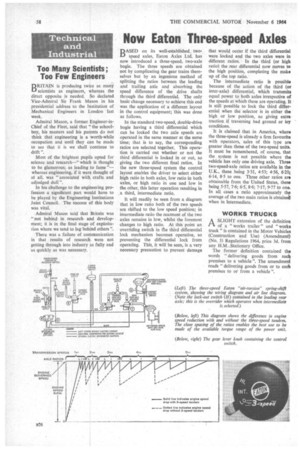Now Eaton Three-speed Axles
Page 60

If you've noticed an error in this article please click here to report it so we can fix it.
BASED on its well-established_ twospeed axles, Eaton Axles Ltd. has now introduced a three-speed, two-axle bogie. The three speeds are obtained not by complicating the gear trains themselves but by an ingenious method of splitting the ratios between the leading and trailing axle and absorbing the speed difference of the drive shafts through the third differential. The only basic change necessary to achieve this end was the application of a different layout in the control equipment; this was done as follows.
In the standard two-speed, double-drive bogie having a third differential which can be locked the two axle speeds are operated in the same manner at the same time; that is to say, the corresponding ratios are selected together. This operation is carried out whether or not the third differential is locked in or out, so giving the two different final ratios. In the new three-speed system the control layout enables the driver to select either high ratio in both axles, low ratio in both axles, or high ratio in one and low in the other, this latter operation resulting in a third, intermediate ratio.
It will readily be seen from a diagram that in low ratio both of the two speeds are shifted to the low speed position; in intermediate ratio the rearmost of the two axles remains in low, whilst the foremost changes to high ratio. At this point an overriding switch in e third differential lock mechanism becomes operative, so preventing the differential lock from operating. This, it will be seen, is a very necessary precaution to prevent damage
that would occur if the third differential were locked and the two axles were in different ratios. In the third (or high ratio) the rear differential now moves to the high position, completing the make up of the top ratio.
The intermediate ratio is possible because of the action of the third (or inter-axle) differential, which transmits equal nower to both axles irrespective of the speeds at which these are operating. It is still possible to lock the third differential when the selector is in either the high or low position, so giving extra. traction if traversing bad ground or icy conditions.
It is claimed that in America, where the three-speed is already a firm favourite with operators, sales of this type are greater than those of the two-speed units. It must be remembered, of course, that the system is not possible where the vehicle has only one driving axle. Three two-speed-axle ratios are available in the U.K.., these being 3-31, 4-53; 4-56, 6-211 6.14, 8.5 to one. Three other ratios are obtainable from the United States, these being 557,76; 6-5, 8-6; 7-17, 9.77 to one. In all cases a ratio approximately the average of the two main ratios is obtaineil when in intermediate.












































































































































































